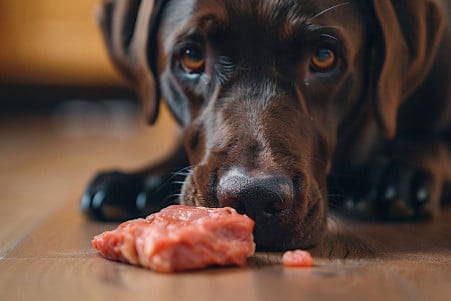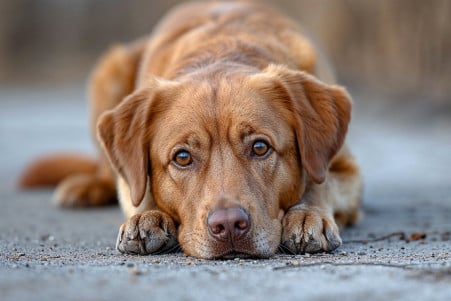How to Stop Food Aggression in Dogs: A Research-Backed Guide
12 June 2024 • Updated 11 June 2024

Does your dog snarl, snap, or bite when you go near their food bowl? Learning how to recognize and deal with food aggression in dogs is important for making sure that you and your pet can eat in peace. While food aggression in dogs can be caused by a lack of socialization, it can also be a result of resource guarding or anxiety, and it can be overcome with time and positive reinforcement training.
In this evidence-based guide, we'll cover everything from the latest research on modifying dog behavior to advice from professional dog trainers to help you learn the most effective ways to stop food aggression and create a stress-free feeding environment for your dog. This comprehensive guide will take into account the psychological and genetic reasons for food guarding and offer solutions that will help you get to the bottom of the issue. With patience and persistence, you can help your dog feel more comfortable at mealtime and deepen the bond you share.
How can I stop food aggression in my dog?
How to Avoid Food Aggression in Puppies
Stopping food aggression before it starts when your puppy is young is important to ensure that your dog will have a healthy relationship with food throughout their life. The ASPCA explains that early socialization and positive reinforcement training are important to prevent guarding instincts from developing. By slowly acclimating your puppy to your presence while they eat through a series of exercises, you can help them learn that people coming near them while they eat is nothing to worry about.
One way to do this is to start by hand-feeding your puppy their meals. This will help them associate you with the positive experience of eating. You can then move on to feeding them from a bowl, but continue to give them a treat every time you come near them while they eat to maintain the positive association. Other exercises, like trading treats for access to the food bowl and using commands like "leave it" can also help reinforce the right behavior.
It's important to be consistent and patient as you work through these exercises. Stick to a schedule, and don't punish your puppy if they show signs of food aggression, as this can make the problem worse. If you're having trouble, even after working with your puppy, it may be time to call in a certified professional dog trainer or behaviorist. With the right training and intervention, you can help your puppy learn to have a healthy relationship with food.
How to Stop Food Aggression in Adult Dogs
Stopping food aggression in adult dogs will require a combination of desensitization and counterconditioning. Elanco explains that the first step is to feed your dog by hand. This way, they will learn to associate you with the good thing that is food.
In the weeks that follow, you can slowly reintroduce the food bowl while still giving your dog treats. Lincolnway Veterinary Clinic recommends strategies like touching the bowl (but not taking it away) and taking the bowl away for a moment during mealtime to show that your dog's food is not in danger when you're around.
It's important to stay calm and avoid punishment, as Raw Bistro explains that confrontation can make food aggression worse. If the problem continues or gets worse, it's time to call in a certified dog trainer or behaviorist who can help you work through the problem with your dog.
How to Deal With Food Aggression in Multi-Dog Homes
Dealing with food aggression in a multi-dog home can be especially difficult because dogs are more likely to feel the need to compete for their resources. According to Deaf Dogs Rock, the first step to dealing with this issue is to separate dogs during feeding time. This can be done by feeding them in different rooms or using crates and baby gates to keep them apart.
To work on modifying food aggression in dogs that live together, the Whole Dog Journal suggests working with a professional to use techniques like the "I Come in Peace" protocol or Constructional Aggression Treatment (CAT). Both of these methods involve slowly introducing the dog that's showing food aggression to the other dog while giving them high-value treats to change their emotional response.
As Jezzie's Place points out, it's important to always be on the lookout for signs of trigger stacking and to have a plan in place for how to deal with a situation if it escalates. This may include using tools like break sticks and air horns to break up a fight. If the situation seems to be getting worse, it's important to get help from a certified dog trainer or behaviorist as soon as possible.
How to Avoid Resource Guarding and Food Aggression
Food aggression in dogs is often a subset of resource guarding, a behavior in which dogs protect items they consider valuable, including food, toys, beds, and even their humans. The Humane Society says that one way to avoid resource guarding between dogs in the same household is to make sure there are enough resources to go around, including toys, beds, and treats. They also say that having a predictable routine and clear rules in the home can help avoid resource guarding.
It's also important to note that VCA Animal Hospitals says that punishing resource guarding is not recommended because it can suppress the dog's natural behaviors and make the problem worse. Instead, they recommend redirecting or asking the dog to do something else when you see the warning signs of resource guarding.
If you're unable to stop resource guarding or if it becomes dangerous, it's time to call in a certified dog trainer or animal behaviorist for help. With the right management and professional help, you can help your dog feel safe without resorting to aggression.
Conclusion: How to Establish a Peaceful Mealtime Routine
The most important thing to remember when it comes to preventing and dealing with food aggression in dogs is that patience is key. All of the methods outlined in this article require time, consistency, and positive reinforcement training.
For puppies, this means working with them to desensitize them to people being around their food and then rewarding them with treats when they display good behavior. This way, you can prevent food aggression from developing in the first place. For adult dogs that are already showing signs of food aggression, the methods of hand-feeding, reintroducing the bowl, and counterconditioning can be used to change their behavior.
For dogs that live in multi-pet households, the methods of separating mealtimes, using management tools, and the "I Come in Peace" protocol can be used to manage food aggression between dogs. In addition, making sure that you address the issue of resource guarding in general by ensuring that there are enough resources to go around and that you are the one who is in charge of them can help to prevent food aggression.
If you find that you're still struggling with food aggression in your dog after trying these methods, it's important to work with a certified dog trainer or behaviorist. However, with the right tools and a lot of patience, you can help your dog feel safe and secure during mealtime.


